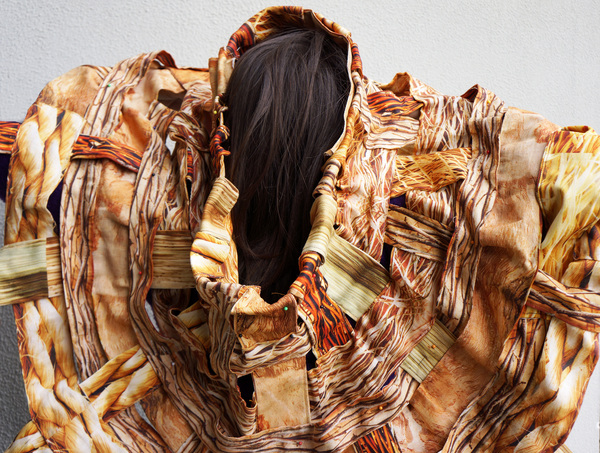Paola Anziche'
dal 3/7/2015 al 4/9/2015
Segnalato da
PsK - Pavillon social Kunstverein
3/7/2015
Paola Anziche'
Pavillon social, Lucca
Vedere con le mani. Il suo lavoro con le fibre tessili ha a che vedere con il sistema di segni che attraverso il costume rivestono il corpo. Il costume, condizione antropologica fondamentale: attitudine, presupposto al comportamento, al gesto, all'interrelazione...

----- english below
Pavillon Social Kunstverein collabora con artisti che ricercano un’interpretazione dei cambiamenti in atto della realtà: un assieme di individui, popoli, culture, minoranze, trasformati nella propria identità e rivolti alle altre all’interno della globalizzazione, come un rispecchiamento.
Per questo motivo la collaborazione con Paola Anziché in questa mostra Vedere con le mani prende piede da un viaggio a Baku, nell’Azerbajan, anche se le opere in mostra fanno parte di famiglie e tempi diversi del proprio lavoro.
Scrive Ivan Bargna:
Baku come molte altre città nel mondo è presa in un moto vorticoso che di giorno in giorno ne muta la fisionomia: i grigi edifici sovietici sono rimessi a nuovo con piastrelle finto antico e gli sventramenti cancellano i vecchi quartieri popolari per far spazio ai grattacieli. La città si veste a nuovo e si traveste: se mai Baku ha avuto un genius loci, oggi sembra averlo smarrito (…)
Paola Anziché fa un ritratto del corpo vivo di Baku.
Il suo lavoro con le fibre tessili ha a che vedere con il sistema di segni che attraverso il costume rivestono il corpo. Il costume, condizione antropologica fondamentale: attitudine, presupposto al comportamento, al gesto, all’interrelazione; nonché attrezzatura per farsi parte del paesaggio (urbano). Per Lévi Strauss i popoli stranieri prendono per prima cosa l’uno dall’altro il costume, il vestiario.
In questa sorta di rispecchiamento fra popoli e globalizzazione, il tessuto della città è considerato qui come il tessuto e le fibre dei corpi: quindi si tratta di ritratti-architettura, che si originano da contesti, luoghi, persone, materiali, storie. Non è un caso se a questo punto riportiamo l’attenzione ai figurinai lucchesi tra sette e novecento. Sembra che sia nato, rilevato dagli artisti, un nuovo ordine di migrazioni; e dissepolta una nuova idea di metamorfosi (sorta dalla serie delle immagini insepolte, poiché il termine oggi è sepolto, appunto, con il significato che si porta dietro, a favore del più strutturale sentire iso-cronico): ovvero, in particolare, si propone l’idea che le opere Yurta, di fibre vegetali, siano dimore-tetti da indossare. Per riassumere quanto suddetto il medium nasce insieme al fare e il fare è anche idea. Nel suo lavoro, ad esempio, quasi imitando i Maggi, rappresentazioni popolari, si imita il rinnovamento del mondo naturale, creando un microcosmo di arbusti, fibre e colori. Esperienze-situazioni che Lygia Clark chiamava proposizioni.
----- english
Pavillon Social Kunstverein collaborates with artists looking for an interpretation of the changes in progress of reality: a gathering of individuals, populations, cultures, minorities, transformed in their own identity and facing those of the others inside the globalization, like a mirror.
Because of this, the collaboration with Paola Anziché in this exhibition Seeing with hands catches on from a trip to Baku, in Azerbajan, even if the exhibited works are part of different families and times even the works on display are part of "families" and different times of their work.
Ivan Bargna writes:
Baku, like many other towns in the world, is caught by a whirling motion which, day by day, changes its physiognomy: the grey Soviet buildings are restored with fake-antique tiles and the demolitions erase the old housing estates in order to make space for the skyscrapers.
The city puts on new clothes and dresses up: if Baku has ever had a genius loci, today it seems to have lost it. Paola Anziché hasn't looked for it and has made a good choice, it was a path which wouldn't have taken anywhere. (…)
Paola Anziché makes a portrait of Baku’s living body.
Her work with textile fibers involves the system of signs which coat the body with the costume. The costume, an anthropological fundamental condition: attitude, assumption of behaviour, of gesture, of inter-relationships; and also a tool in order to become part of the (urban) scenery. For Lévi Strauss, foreign populations take the costume from each other first thing, the clothing.
In this kind of mirroring between populations and globalization, the fabric of the city is here considered like the tissue and the fibers of the bodies: thus these are portraits-architecture, which originate from contexts, places, people, materials, stories. It’s not a coincidence that we now bring back the attention to the painters of Lucca of the 18th and 19th century. It seems that a new order of migration is born, detected by the artists; and a new idea of metamorphosis is unearthed (born from the series of unburied images, because the term today is buried, as a matter of fact, with the meaning it brings with itself, in favour of the more structural isochronistic feeling): or else, in particular, she proposes the idea that the Yurkas works, made of vegetable fibers, are houses-roofs to wear. To sum this up, the medium is born along with the doing and the doing is also an idea. In her work, for example, almost as if she’s imitating the Maggis, popular representations, the renewal of the natural world is imitated, creating a microcosm of shrubs, fibers and colours. Experiences-situations that Lygia Clark called propositions.
Inaugurazione 4 luglio ore 18:30
Pavillon social
via Antonio Mordini, 64 (gia' via Nuova) Lucca
sab-dom 16:30-18:30
ingresso libero



